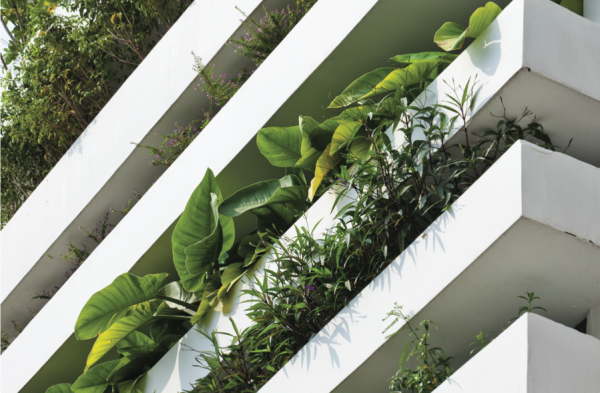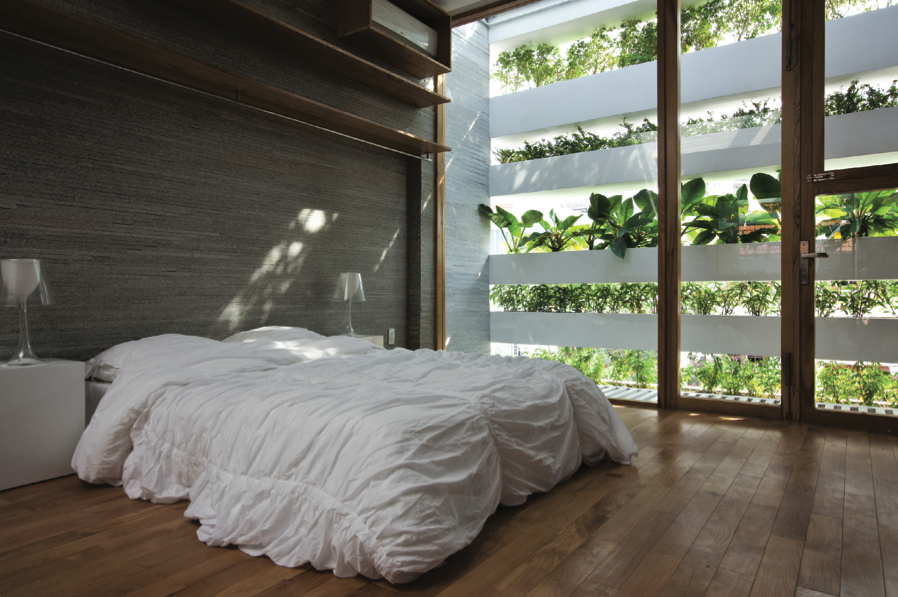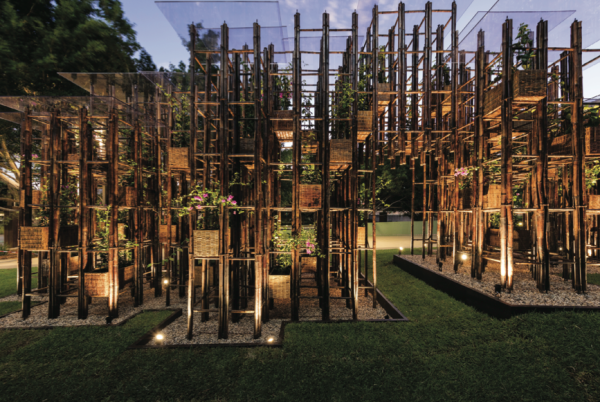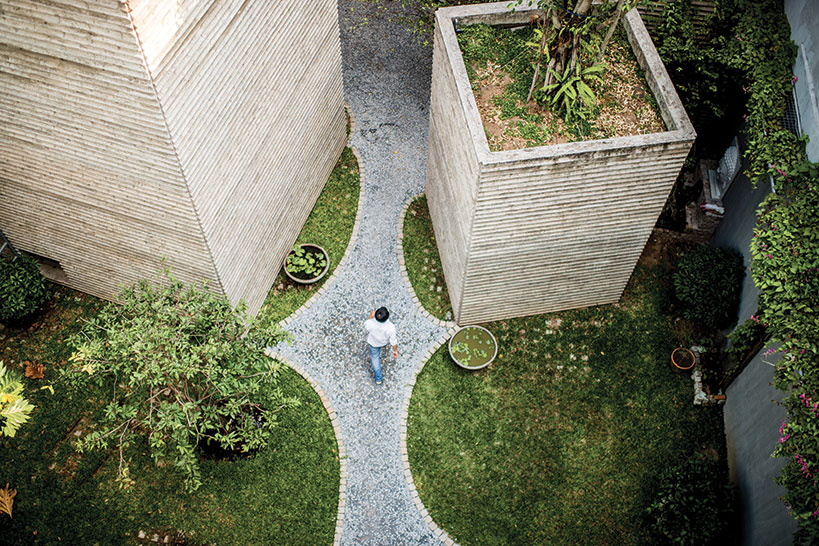
Green shoots: the evolution of high-rise gardens
Share
Written by Graham Crist. Above: House for Trees by Vo Trong Nghia Architects.
My urban neighbours are 30- and 40-storey apartment towers. Though they are mostly shiny and new, the cracks in their tightly composed façades are slowly accumulating surface junk. Laundry, plastic furniture, crates, bikes, struggling plants. These are signs of ordinary life emanating from CBD tower skins. Until recently, that life usually meant suburban houses with garden, car and the messy additions. The dense new towers in Australian cities have not really aimed to replicate that life, but to recast it for students, retirees, young professionals. What remains is to reconcile tower lifestyles with suburban life, bringing the informal openness of the bungalow up onto elevated floors, especially the garden and mess.
Vietnamese cities, despite their high density, have great traditions of green foliage wrapped into their built fabric. Planting wedged into tiny street spaces, gardens on roof terraces up above skinny houses catching the breeze, lush leafy slivers on façades everywhere. It matches the piles of fresh herbs of the street food markets.
This image of a city is at odds with global curtain walled towers. This second image is fast replacing the former in centres, such as Ho Chi Minh City, where the pressure of the large footprint high-rise is extinguishing the jungle. Around the perimeter of the Bitexco Financial Tower, the street level contrast is startling. Both plaza and podium models are grey and dry.
The practice of Vo Trong Nghia Architects (VTNA) has developed an explicit engagement with this dilemma. Its body of work directly evoking the bamboo jungle at two levels. First, the bamboo becomes the fabric of the building, where the jungle has reconstituted itself in a new form, and second, architectural structure becomes a scaffold support, for the reintroduction of green foliage space. The Sherman Contemporary Art Foundation recently commissioned VTNA as part of Fugitive Structures, its annual architectural pavilion series, with VTNA adopting both of these strategies in Green Ladder. An earlier series of remarkable pavilions exploited both the vernacular intelligence and advanced structural possibilities of bamboo. By contrast, VTNA’s Fugitive Structure is straightforward in its geometry, but acts as a frame supporting boxes of planting. This strategy is prevalent across VTNA’s largest projects and is most explicit in the project, Stacking Green, where Vietnamese tube houses are reconceived as a series of trays for plants. At its most extreme, the House for Trees is described as a series of ‘pots’ for large tropical trees, conceptually making its interior a cavity beneath soil and roots.
These strategies recall Le Corbusier’s ‘grille climatique’ of the Millowners at Ahmedabad and, more recently, Ken Yeang’s tower series, with its forms such as the Nera Tower increasingly eroded by vegetation. In Emilio Ambasz and Associates’ Fukuoka Prefectural International Hall, the civic expression is rendered entirely through a wild terraced garden. The lineage of the public garden as a gesture of both the exceptional and the civic becomes more acutely felt as urban green space is increasingly eaten away. Many contemporary architects have identified this, with claims of ‘bringing nature back to the city’, such as ARM’s fantastical garden on top of the Flinders Street Station competition redevelopment project and even Daniel Libeskind’s planned New York tower.
Apartment projects the likes of One Central Park in Sydney, designed by Atelier Jean Nouvel with collaborating architect PTW Architects (with its vertical landscape designed in collaboration with French botanist and artist, Patrick Blanc) or Breathe Architecture’s Nightingale Apartments in Melbourne, foreground vertical planting to its image of housing, and begin tentatively to reconcile the garden with the house in the sky, overcoming the urban bifurcation into garden suburbs and commercial central business districts. Son Nguyen’s more speculative project, Village Tower in Hanoi (a graduating thesis project at RMIT), overtly stretches the fine-grained complexity of the old city up into a tower. The vertical village takes the micro-green space with it and uses it to smash up the monoculture of the podium and tower.
This returns us to the opening subject of this text – towers, gardens and everyday life. The purpose and the impact of greening city architecture, and VTNA’s body of work, require subtle differentiation. The exceptional civic oasis that provides relief from the dense city is one form these projects take. The bamboo pavilions, or hotel resorts, are examples that rely on their contrast to the built city. A second impulse is to subsume the architecture in planting, as though returning the city to its natural state. VTNA’s image of the FTP campus imagines a Utopian jungle swallowing the architecture and marching on to take back the rest of the city.
A third strategy is the built form as an armature for inhabitation by the garden – a place that accepts the do-it-yourself slices of planting filling the cracks. This reflects one of the best qualities of Vietnamese cities – the ability to intensely use space and create micro-gardens out of nothing.
VTNA claims that 0.25 percent of the area of Ho Chi Minh City is covered in greenery. I doubt this figure accounts for the private micro-garden spaces, which are so difficult to account for collectively. These crucial spaces are the kind that the Stacking Green project is pointing to. In the push to bring nature back to the city, we should be wary of the opposite scale. As Ho Chi Minh City embraces the green-less high-rise, it is building luxury developments of villas and towers with large green spaces and, by local standards, very low density. Sometimes these are called eco-cities. The paradox of the garden city is that the desire to reconnect the urban dweller with nature contributes to the sprawling, car-choked metropolis. The self-made, tiny and varied gardens in dense cities are often more like the messy balcony and less like the perfectly rendered green blanket of architectural images. Handing these spaces to owners who expertly micro-manage them nevertheless has more varied aesthetic results than the designer can bear. The relentless and exaggerated greenery of VTNA’s work is impressive, yet the differentiation, the self- management and the scaling into tiny spaces, is what will make it powerful at the scale of a whole metropolis.
The big question, and design problem, is how to bring what is best about the city, up to the elevated spaces of the high-rise. What is best in a Vietnamese city is the spatial intelligence embodied in tiny and finely wrought urban spaces. The task is to hold on to these spaces and elevate them, without being scaled up and lost. Perhaps the Australian hybrid has the informality of the suburban garden at the scale of the CBD. It has much development to undergo.
AR144 is available now through newsstands and digitally through Zinio.




















